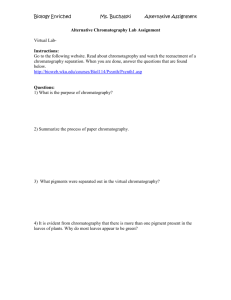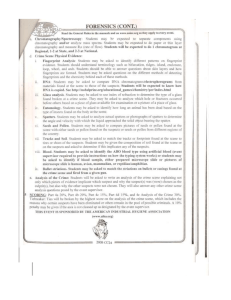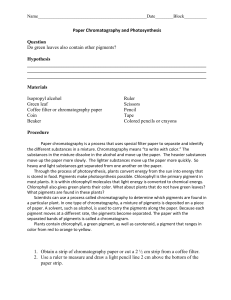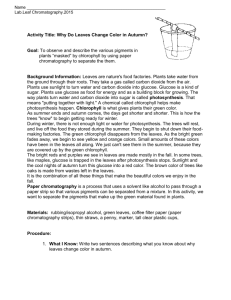Name: Date:______ Block
advertisement
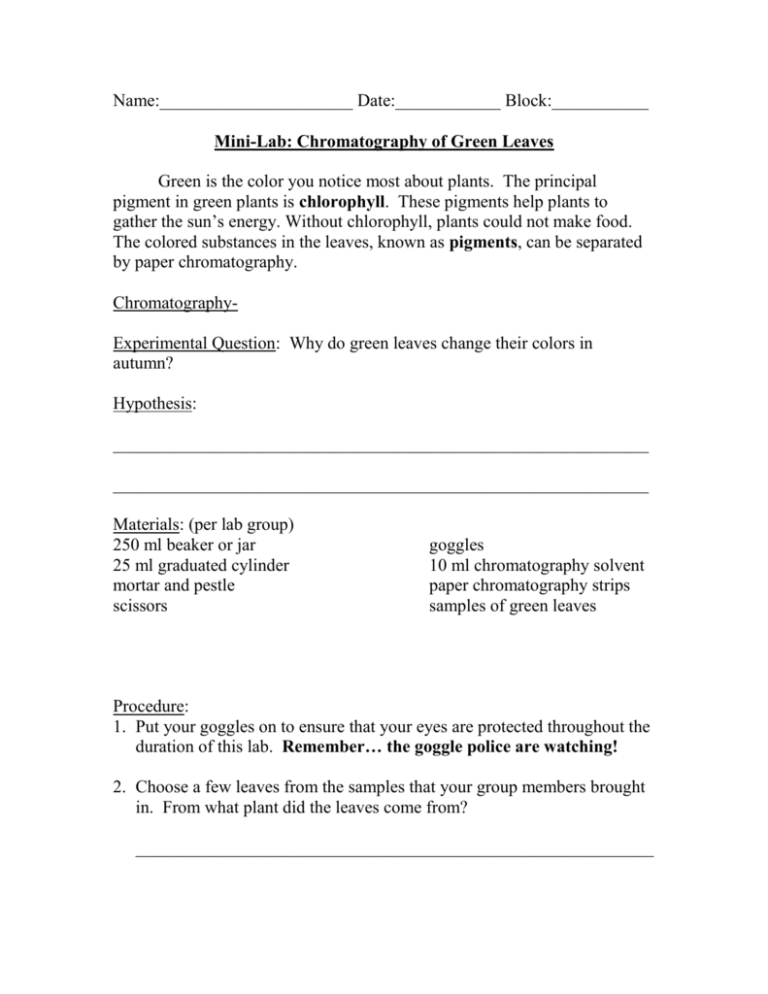
Name:______________________ Date:____________ Block:___________ Mini-Lab: Chromatography of Green Leaves Green is the color you notice most about plants. The principal pigment in green plants is chlorophyll. These pigments help plants to gather the sun’s energy. Without chlorophyll, plants could not make food. The colored substances in the leaves, known as pigments, can be separated by paper chromatography. ChromatographyExperimental Question: Why do green leaves change their colors in autumn? Hypothesis: _____________________________________________________________ _____________________________________________________________ Materials: (per lab group) 250 ml beaker or jar 25 ml graduated cylinder mortar and pestle scissors goggles 10 ml chromatography solvent paper chromatography strips samples of green leaves Procedure: 1. Put your goggles on to ensure that your eyes are protected throughout the duration of this lab. Remember… the goggle police are watching! 2. Choose a few leaves from the samples that your group members brought in. From what plant did the leaves come from? ___________________________________________________________ 3. Tear the leaves into small pieces (about the size of a postage stamp). Place the pieces in a mortar. Grind them to a paste with the pestle, using a circular motion as pictured in the diagram below. 4. Add 10 ml of acetone. Continue grinding until the liquid is deep green in color. Group members should take turns grinding. 5. Pour the green pigment solution into a 250 ml beaker. 6. Obtain a strip of chromatography paper, one for each group member. Caution: Be sure to only hold the strips of chromatography paper on the edges, as oils from your fingers could affect results. 7. Take one end of the chromatography paper strip and make a fold about one inch from the end. Write your initials on this fold. This fold will help anchor your strip. 8. Place the other end of the chromatography strip into the green solution and place the fold you made in step 7 over the edge of the beaker. 9. Watch the colored rings from in the filter paper for about 10-15 minutes. a. What color appears first? ___________________________________ b. How many rings of this color are there? ________________________ c. What color appears next? ___________________________________ d. How many rings of this color are there? ________________________ 10.Wash the mortar and pestle thoroughly. Make sure to wash and return materials to the materials table. 11.Glue your chromatography strip to your lab report under the analysis section. Analysis Questions: (To be done in complete sentences!) 1. Describe the appearance of the chromatography strip at the conclusion of the experiment. ___________________________________________________________ ___________________________________________________________ ___________________________________________________________ 2. a. Is chlorophyll composed of one or several pigments? b. What proof do you have? _____________________________________________________________________ _____________________________________________________________________ _____________________________________________________________________ 3. Examine your chromatography strip. Each color band is a different pigment. Listed in order from top to bottom on an ideal chromatogram are… Carotene- orange in color Xanthophyll- yellow in color Chlorophyll a- bright green in color Chlorophyll b- a dull or khaki green color What pigments can you see on your chromatogram? ___________________________________________________________ ___________________________________________________________ 4. Many leaves change color in the fall. Propose a hypothesis for how it is possible for this color change to happen based on your new knowledge of pigments present in chloroplasts. (Hint- Chlorophyll a and b are easily broken down by the cooler autumn temperatures). ___________________________________________________________ ___________________________________________________________ ___________________________________________________________ ___________________________________________________________ ___________________________________________________________ ___________________________________________________________ Glue your chromatogram here….

